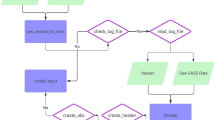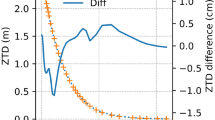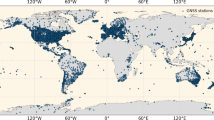Abstract
It has been demonstrated that precise point positioning (PPP) is a powerful tool in geodetic and geodynamic applications. As is known, it provides solutions in the reference system of the satellite orbits. We focuses on the strategy to transform PPP solutions into the International Terrestrial Reference System (ITRS) by applying a set of local Helmert transformation parameters obtained from a regional network rather than using global parameters. In order to carry out this test, a regional network composed of 14 stations was analyzed using GIPSY-OASIS II software, over a period of 6 years. Two solutions differently aligned to the ITRS were compared in terms of accuracy, scattering, frequency content and local movements. One solution is aligned to IGb08 through the X-files provided by JPL, while the other is aligned to the European reference frame densification of IGb08 using customized regional X-files. Therefore, both are updated realizations of the ITRS. The test shows that a regional, instead of a global, alignment to the ITRS can significantly improve the repeatability of the solutions. A small improvement can also be found in terms of agreement with the regional densification of IGb08. The analysis of the signal content in the differently aligned time series allowed some differences to be found, in terms of both frequency and magnitude. These differences are mainly due to an evident common signal that is defined for the whole area and which is removed when using regional alignment. Finally, residual scattering was calculated after removing the modeled signals from each time series, which results in a scatter being significantly smaller for the regional solution than for the global solution. In order to obtain these results, the choice of the reference stations is a major question and therefore discussed in detail.






Similar content being viewed by others
References
Altamimi Z, Boucher C (2002) The ITRS and ETRS89 relationship: new results from ITRF2000. In: Torres J, Hornik H (eds) Mitteilungen des BKG, vol 10. EUREF, Frankfurt, pp 49–52
Barbarella M, Gandolfi S, Ricucci L, Zanutta A (2009) The new Italian geodetic reference network (RDN): a comparison of solutions using different software packages. In: Proceedings of EUREF symposium, Florence, Italy, 27–30 May
Bertiger W, Desai SD, Haines B, Harvey M, Moore AW, Owen S, Weiss JO (2010) Single receiver phase ambiguity resolution with GPS data. J Geod 84(5):327–337
Bisnath S, Gao Y (2009) Current state of precise point positioning and future prospects and limitations. In: Observing our changing earth. Springer, Berlin, pp 615–623. doi:10.1007/978-3-540-85426-5_71
Boucher C, Altamimi Z (2011) Memo: specifications for reference frame fixing in the analysis of a EUREF GPS campaign. http://etrs89.ensg.ign.fr/memo-V8.pdf
Bruyninx C, Becker M, Stangl G (2001) Regional densification of the IGS in Europe using the EUREF permanent GPS network (EPN). Phys Chem Earth, Part A 26(6):531–538
Bruyninx C, Altamimi Z, Caporali A, Kenyeres A, Lidberg M, Stangl G, Torres JA (2013) Guidelines for EUREF densifications. ftp://epncb.oma.be/pub/general/Guidelines_for_EUREF_Densifications.pdf
Dong D, Fang P, Bock Y, Cheng MK, Miyazaki S (2002) Anatomy of apparent seasonal variations from GPS-derived site position time series. J Geophys Res 107(B4):2075
Freymueller J (2009) Seasonal position variations and regional reference frame realization. In: Geodetic reference frames. Springer, Berlin, pp 191–196
Griffiths J, Ray JR (2009) On the precision and accuracy of IGS orbits. J Geod 83(3–4):277–287
Hurst K (1995) Precise orbital products available from JPL. GIPSY-OASIS II Newsletter. V2N1, 1–3. ftp://sideshow.jpl.nasa.gov/pub/usrs/PS-DOCUMENTS/GOA_newsletter_v2n1.ps
Kedar S, Hajj GA, Wilson BD, Heflin MB (2003) The effect of the second order GPS ionospheric correction on receiver positions. Geophys Res Lett 30(16):1829
Kouba J (2008) Implementation and testing of the gridded Vienna mapping function 1 (VMF1). J Geod 82(4–5):193–205
Legrand J, Bruyninx C (2009) EPN reference frame alignment: consistency of the station positions. Bull Geod Geomat 68:19–34
Lomb NR (1976) Least-squares frequency analysis of unequally spaced data. Astrophys Space Sci 39(2):447–462
Mao A, Harrison CGA, Dixon TH (1999) Noise in GPS coordinate time series. J Geophys Res 104(B2):2797–2816
Pearson K (1895) Note on regression and inheritance in the case of two parents. Proc R Soc Lond 58(347–352):240–242
Rebischung P, Griffiths J, Ray J, Schmid R, Collilieux X, Garayt B (2011) IGS08: the IGS realization of ITRF2008. GPS Solut 16(4):483–494
Rebischung P (2012) [IGSMAIL-6663] IGb08: an update on IGS08. https://igscb.jpl.nasa.gov/pipermail/igsmail/2012/007853.html
Scargle JD (1982) Studies in astronomical time series analysis. II-Statistical aspects of spectral analysis of unevenly spaced data. Astrophys J 263:835–853
Völksen C (2005) Stochastic deficiencies using precise point positioning. In: Proceeding of EUREF symposium of the IAG sub-commission for Europe (EUREF). Bratislava, Slovakia, 2–5 June 2004, EUREF Publication No. 14, Mitteilungen des Bundesamtes für Kartographie und Geodäsie, Band 35, pp 302–308
Wang G, Kearns T, Yu J, Saenz G (2014) A stable reference frame for landslide monitoring using GPS in the Puerto Rico and Virgin Islands region Landslides 11:119–129
Webb FH, Zumberge JF (1997) An introduction to GIPSY/OASIS-II. JPL Publication D-11088, Jet Propulsion Lab, Pasadena
Acknowledgments
We are grateful to the unknown reviewers for their constructive suggestions and comments that allowed a significant improvement of the paper. We also thank the Generic Mapping Tools (GMT) development team for its useful work.
Author information
Authors and Affiliations
Corresponding author
Rights and permissions
About this article
Cite this article
Gandolfi, S., Tavasci, L. & Poluzzi, L. Improved PPP performance in regional networks. GPS Solut 20, 485–497 (2016). https://doi.org/10.1007/s10291-015-0459-z
Received:
Accepted:
Published:
Issue Date:
DOI: https://doi.org/10.1007/s10291-015-0459-z




